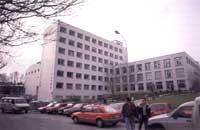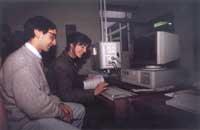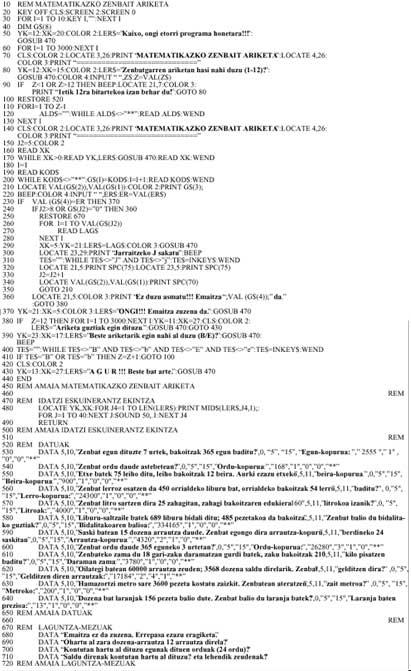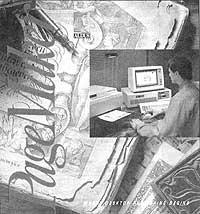Law and informatics. Right by computer
1992/02/01 Alkorta Idiazkez, Itziar - Bioetikan aditua eta aritua. Zuzenbide Zibileko irakasleaEHU | Goñi, Santi | Karrera, Mikel | Lizaso, Pili - Informatika SailaElhuyar Fundazioa Iturria: Elhuyar aldizkaria
From abacus to microchips
Since the abacus used in antiquity to teach the general principles of arithmetic has been spent a long time to the current electric computer. On the road to automation, the first electronic computer was created by Professor Howard Aiken in 1944 in the United States. This machine operated by relays, in addition to orders and instructions recorded on the perforated cards, it worked with data stored in memory.
Since then, efforts have been made to make these machines smaller and smaller, while increasing their capacity and data processing speed. Thanks to complicated software, nowadays any computer user can be, even if only have a little knowledge of the computer.
On the other hand, the extension of so-called computing or science for the automatic treatment of information is one of the causes of the rapid social change that we live. As for the legal world, this new science offers us means to reach a more concrete and clear law, both at the level of use and in the application itself.

Moreover, new technology is changing the thinking of jurists. Therefore, there is no choice but to adapt these new methods to the legal professional, even if only to address old issues from a different perspective and adapt their legal activity to technological development.
Status of legal information
The relationship between Informatics and Law takes place in two areas. On the one hand, the current activity on Law Day can count on the support of computer science, called Legal Informatics. On the other hand, governing the influence of computer science in society is a task of law, computer law.
Since the object of this article is to make known a concrete application of the first field, we are now in charge of giving an introduction and an overview to this science. As previously suggested, Legal Informatics provides great support to the professional activity of law. Currently, this science has developed three differentiated applications: support for the management of legal activity (for example, word processors and management programs for use in law offices); the possibility of saving and retrieving legal documentation on magnetic support (databases for consultation of legislation, jurisprudence and doctrine); the possibility of helping the resolution and resolution of computer disputes (known as Expert Systems).
Software application
The recent application of the professors of Civil Law of the Faculty of Law of San Sebastian, in collaboration with the computer team of Elhuyar, meets a very interesting variant the second of the aforementioned functions, since the automated system devised and executed by this group, in addition to gathering the legislation and doctrine to treat a certain area of civil law, allows practical exercises on this area.
The objective of the project was to develop a method that could help the learning of civil law. In short, offer an alternative to traditional methods through which users of the application:
You can quickly locate data on the specific topic you are interested in. The application has a series of menus that collect the main headings of the topic, allowing the user to know immediately where you will find. This has the advantage that textbook summaries have no advantage, that is, when giving the computer a reference key (a word, a number, any other sign) immediately apantallen the requests to the user. You can also access the requested information via a printer.

As for the exercises (taking into account that the user can go directly to this part of the program if he so wishes and once the exercises are introduced you can return to the dogmatic part back), as in the previous section, the user is given a menu in which the exercises correspond to each of the sections of the theoretical part in which he finds them. At the time of resolving them, the program plays the role of teacher, indicating in the first place if the response you have given to the user is correct or not; in case of not successful, offering help before giving you the option to answer again; and in case you do not get to respond correctly after the last session.
On the other hand, it must be said that when presenting the exercises it has acted with the concept of randomness so used in computer science. This allows you to create a set of exercises from a statement. For example, among the possible answers that will be offered in test questions, there will always be a correct one (it may happen that this is also different from one session to another) but the rest of the options will not always be the same. This system requires deeper reflection, and although the same exercises are repeated more than once, the habit of automatic response is ruled out.
When selecting a section of the topic, the order of the exercises is fixed, since as a first step it has been considered more appropriate to solve the exercises in the logical order that the subject requires. However, if you want to use the app as a review, you can also order mixed exercises.
The fruits of the first session of this approach between law and computer professors demand continuity. As one of the most valued activities in today's society is the capacity for information and information processing, jurists cannot avoid this new challenge. Even less so when the results of the work have been so positive and so useful.

Gai honi buruzko eduki gehiago
Elhuyarrek garatutako teknologia





